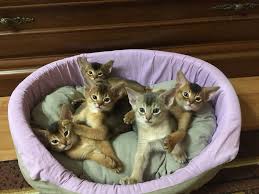It’s a quiet afternoon, and you walk into the room where your cat gave birth just a few days ago. Suddenly, you notice something odd: she’s carefully picking up her tiny kittens one by one and trying to move them somewhere else. Maybe it’s under the bed, into a closet, or even into your laundry basket. You might be thinking — why is my cat trying to move her kittens? Is she unhappy with the spot you gave her? Is something wrong with the kittens? Or is this simply natural behavior?
If you’ve found yourself asking these questions, you’re not alone. Many new cat parents are surprised, sometimes even alarmed, when their mama cat starts carrying her babies around. The good news is, most of the time, this is normal feline behavior with very natural instincts behind it. But sometimes, it can also signal discomfort, stress, or a problem that needs your attention.
In this article, we’ll break down exactly why mother cats move their kittens, when it’s completely normal, and when you should step in to help. You’ll also learn how to create the safest and most comfortable environment for your cat and her litter — so everyone stays healthy, happy, and stress-free.

Understanding the Instinct: Why Do Mother Cats Move Their Kittens?
Before we jump into the specific reasons, it’s important to remember that cats are instinct-driven animals. In the wild, a mother cat (or “queen”) would need to protect her vulnerable kittens from predators, harsh weather, or threats from other cats. Even though your indoor cat doesn’t face those dangers, her instincts haven’t disappeared.
Moving kittens is often her way of making sure they’re safe, comfortable, and secure. Now let’s break down the most common reasons.
Common Reasons Why Cats Try to Move Their Kittens
1. Instinct to Protect From Danger
In nature, a nest that smells strongly of milk and kittens might attract predators. A mother cat may move her litter every few days to reduce this risk. Indoor cats don’t face predators, but the instinct is still strong — especially if there’s noise, strangers, or other pets around.
2. The Current Spot Feels Unsafe or Too Noisy
If your cat gave birth in a busy room — like your living room, kitchen, or somewhere with frequent foot traffic — she might decide it’s not ideal. Loud noises, bright lights, or curious children and pets can all make her feel uneasy.
3. Temperature Concerns
Kittens can’t regulate their own body temperature for the first few weeks of life. If the nesting area feels too cold, too hot, or drafty, mama cat may try to move them to a spot that feels “just right.”
4. Privacy and Quiet
Mother cats crave privacy after giving birth. If she feels like she’s constantly being watched, touched, or interrupted, she may look for a more secluded spot.
5. Bonding and Comfort
Sometimes, cats move kittens simply because the new spot feels more comfortable — softer bedding, a darker corner, or a place where she feels more in control.
6. Health-Related Concerns
Occasionally, a cat may separate or try to move one kitten that seems weaker or sick. This isn’t neglect — it’s another instinctual behavior. She may be trying to protect the healthier kittens by moving them away from one that might be ill.
Is It Normal for Cats to Move Kittens?
Yes — it’s perfectly normal. Most new mothers will attempt to move their kittens at least once during the first few weeks. As long as she’s gentle, attentive, and the kittens remain healthy, this behavior is usually nothing to worry about.
When Should You Be Concerned?
While moving kittens is natural, there are times when it signals something more serious. Watch out for these red flags:
-
Excessive moving: If she keeps relocating the kittens multiple times in a single day, she may be stressed or uncomfortable.
-
Abandoning a kitten: If she moves some kittens but leaves one behind consistently, that kitten may need veterinary attention.
-
Signs of illness in the mother: If she seems lethargic, refuses to nurse, or appears in pain, contact your vet.
-
Unsafe locations: Sometimes, cats try to move kittens into dangerous spots (like under appliances or inside closets with small gaps).
How You Can Help Your Cat and Her Kittens
If your cat is trying to move her kittens, the best thing you can do is support her natural instincts while keeping everyone safe. Here’s how:
1. Provide a Safe Nesting Box
Offer a quiet, enclosed box or crate lined with soft blankets. Keep it in a warm, dark, low-traffic area of your home.
2. Limit Disturbances
As tempting as it is to peek at the kittens all the time, try to give mama cat some privacy. Limit visitors, keep children and other pets away, and avoid moving the kittens yourself unless absolutely necessary.
3. Maintain a Comfortable Temperature
Keep the room warm (around 75–80°F / 24–27°C) and draft-free. Heating pads should be used with extreme caution and only under half the nesting area so kittens can move away if they get too warm.
4. Let Her Have Some Say
If your cat insists on a certain spot — and it’s safe — consider making that her new nest. Sometimes the best solution is to adapt to her choice.
5. Monitor Kitten Health
Check that all kittens are nursing, gaining weight, and staying warm. If any appear weak, cold, or aren’t feeding, consult your vet immediately.
Common Mistakes to Avoid
-
Moving the kittens yourself unnecessarily. This can stress the mother and make her more determined to relocate them.
-
Allowing too much human contact early on. Handling should be minimal in the first couple of weeks.
-
Ignoring unsafe spots. If she insists on moving them somewhere dangerous, gently relocate the entire litter (including bedding) back to a safe box.
Real-Life Example
One cat owner shared how her queen kept moving her kittens under the bed. The owner was worried, but after realizing the bedroom was quieter and darker than the original nesting box in the living room, she decided to let her cat keep them there. The kittens thrived, and the mother felt more secure.
This shows that sometimes, your cat knows best.

Frequently Asked Questions (FAQs)
Why does my cat keep trying to move her kittens back and forth?
She may feel uncertain about the nest, or something in the environment is stressing her. Try to reduce noise, give her privacy, and offer a secure nesting box.
Can I stop my cat from moving her kittens?
You shouldn’t force her to stop, but you can encourage her to stay put by making the nest more appealing — quiet, dark, warm, and safe.
Is it bad if my cat moves her kittens?
Not at all — it’s normal. Just make sure the new location is safe and the kittens are not at risk.
Why is my cat only moving one kitten?
She may sense that the kitten is unwell or struggling. Monitor closely and seek veterinary advice if the kitten seems weak, cold, or isn’t feeding.
How long will my cat keep moving her kittens?
Usually, cats may move kittens during the first few weeks. Once the kittens are older, stronger, and starting to explore, the need to move them decreases.
Final Thoughts
If you’ve been worried about “why is my cat trying to move her kittens,” the answer is usually simple: she’s following her natural instincts to protect and care for them. Most of the time, it’s completely normal and nothing to panic about. Your role is to provide a safe, quiet, and comfortable environment — and to step in only if the kittens’ safety or health is at risk.
With patience, understanding, and a little flexibility, you’ll help your mama cat feel secure while giving her kittens the best possible start in life.
